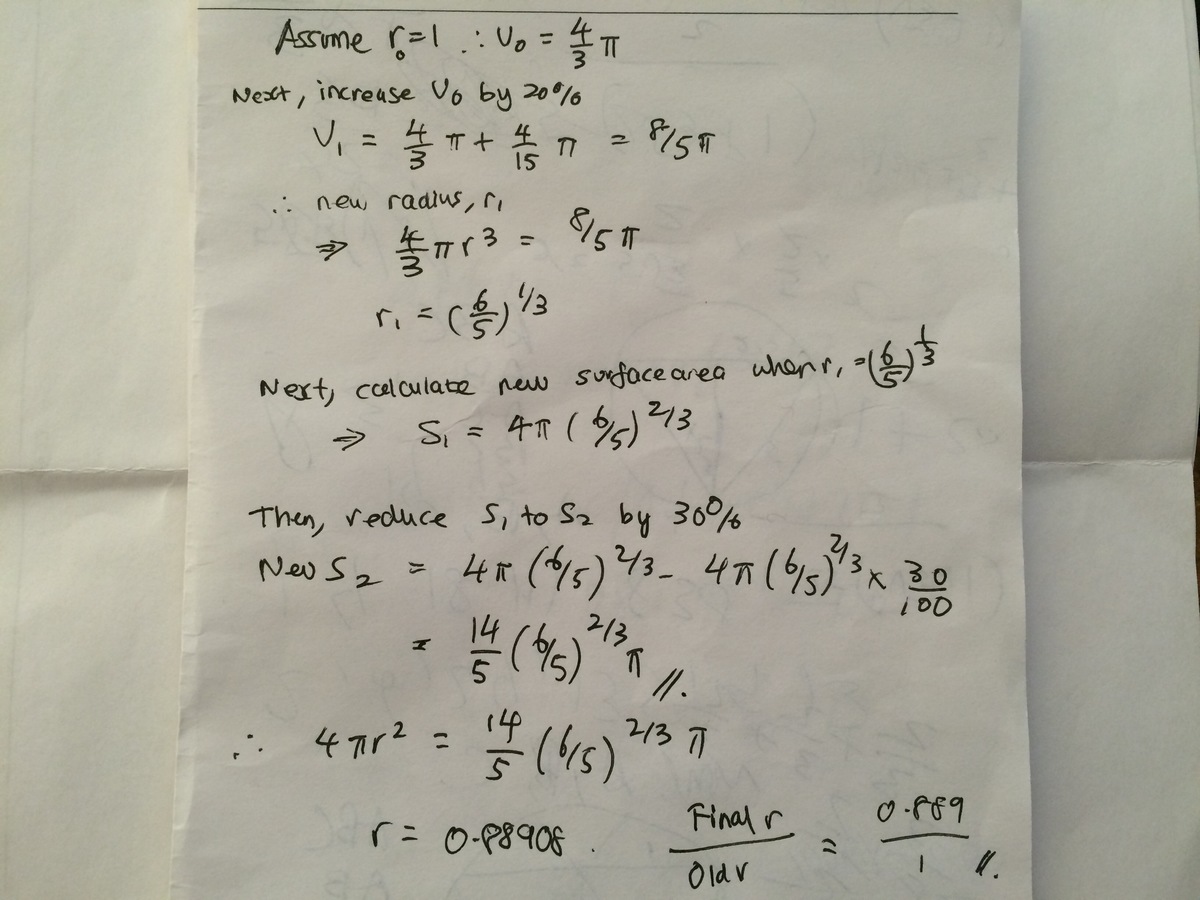Harry Potter And The Magical Sphere
Harry Potter is playing with a Magic Sphere today, which remains as a sphere even as he changes it's physical properties.
He first increases the volume of Magic Sphere by
2
0
%
.
Then he decreases the surface area by
3
0
%
.
Compute original radius of Magic Sphere final radius of Magic Sphere .
Give your answer to 3 decimal places.
The answer is 0.889.
This section requires Javascript.
You are seeing this because something didn't load right. We suggest you, (a) try
refreshing the page, (b) enabling javascript if it is disabled on your browser and,
finally, (c)
loading the
non-javascript version of this page
. We're sorry about the hassle.
3 solutions
Exactly. The only thing we need to compute is the ratio, not the actual volume, area or radius.
Let the initial radius be r . Then the initial volume will be 3 4 π r 3 . Let the volume and the radius after increment be V i and x . Hence, we have V i = 3 4 π r 3 + 1 0 0 2 0 × 3 4 π r 3 3 4 π x 3 = 3 4 π r 3 ( 1 + 5 1 ) 3 4 π x 3 = 3 4 π r 3 × 5 6 3 4 π x 3 = 5 8 π r 3 x 3 = 5 6 r 3 x = 3 5 6 r ⋯ ( 1 ) Let the surface area after decrement be A d and the final radius be R . Therefore, A d = 4 π x 2 − 1 0 0 3 0 × 4 π x 2 4 π R 2 = 4 π x 2 ( 1 − 1 0 3 ) R 2 = ( 3 5 6 r ) 2 × 1 0 7 R 2 = ( 3 2 5 3 6 ) r 2 × 1 0 7 r 2 R 2 = 1 0 7 3 1 . 4 4 ( r R ) 2 ≈ 1 0 7 × 1 . 1 2 9 2 4 3 ( r R ) 2 ≈ 0 . 7 9 0 4 7 0 1 r R ≈ 0 . 8 8 9

For similar figures (which all spheres are), multiplying corresponding lengths by a factor of k multiplies corresponding areas by a factor of k 2 and corresponding volumes by a factor of k 3 . Therefore multiplying a surface area by a factor s would multiply a length by a factor of s 1 / 2 and multiplying a volume by a factor v would multiply a length by a factor of v 1 / 3 .
For any radius r 0 , increasing the volume of the magic sphere by 20% means that the volume factor is v = 1 . 2 or v = 5 6 , and the radius multiplies by a factor of ( 5 6 ) 1 / 3 . Then decreasing the surface area of the magic sphere by 30% means the surface area factor is s = 1 0 7 and the radius would be multiplied by ( 1 0 7 ) 1 / 2 .
This means the final radius r f = r 0 ( 5 6 ) 1 / 3 ( 1 0 7 ) 1 / 2 and thus, r 0 r f = ( 5 6 ) 1 / 3 ( 1 0 7 ) 1 / 2 ≈ . 8 8 9